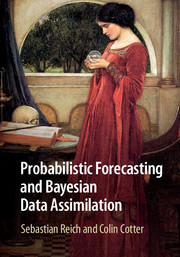Refine search
Actions for selected content:
2540 results in Computational Science
Restricting unipotent characters in special orthogonal groups
- Part of
-
- Journal:
- LMS Journal of Computation and Mathematics / Volume 18 / Issue 1 / 2015
- Published online by Cambridge University Press:
- 01 July 2015, pp. 456-488
-
- Article
-
- You have access
- Export citation
Heuristics on pairing-friendly abelian varieties
- Part of
-
- Journal:
- LMS Journal of Computation and Mathematics / Volume 18 / Issue 1 / 2015
- Published online by Cambridge University Press:
- 01 June 2015, pp. 419-443
-
- Article
-
- You have access
- Export citation
1 - Prologue: how to produce forecasts
-
- Book:
- Probabilistic Forecasting and Bayesian Data Assimilation
- Published online:
- 05 May 2015
- Print publication:
- 14 May 2015, pp 1-30
-
- Chapter
- Export citation
Index
-
- Book:
- Probabilistic Forecasting and Bayesian Data Assimilation
- Published online:
- 05 May 2015
- Print publication:
- 14 May 2015, pp 295-297
-
- Chapter
- Export citation
A postscript
-
- Book:
- Probabilistic Forecasting and Bayesian Data Assimilation
- Published online:
- 05 May 2015
- Print publication:
- 14 May 2015, pp 288-288
-
- Chapter
- Export citation
9 - Dealing with imperfect models
- from Part II - Bayesian Data Assimilation
-
- Book:
- Probabilistic Forecasting and Bayesian Data Assimilation
- Published online:
- 05 May 2015
- Print publication:
- 14 May 2015, pp 259-287
-
- Chapter
- Export citation
Part I - Quantifying Uncertainty
-
- Book:
- Probabilistic Forecasting and Bayesian Data Assimilation
- Published online:
- 05 May 2015
- Print publication:
- 14 May 2015, pp 31-32
-
- Chapter
- Export citation
Preface
-
- Book:
- Probabilistic Forecasting and Bayesian Data Assimilation
- Published online:
- 05 May 2015
- Print publication:
- 14 May 2015, pp vii-x
-
- Chapter
- Export citation
Contents
-
- Book:
- Probabilistic Forecasting and Bayesian Data Assimilation
- Published online:
- 05 May 2015
- Print publication:
- 14 May 2015, pp v-vi
-
- Chapter
- Export citation
Frontmatter
-
- Book:
- Probabilistic Forecasting and Bayesian Data Assimilation
- Published online:
- 05 May 2015
- Print publication:
- 14 May 2015, pp i-iv
-
- Chapter
- Export citation
8 - Data assimilation for spatio-temporal processes
- from Part II - Bayesian Data Assimilation
-
- Book:
- Probabilistic Forecasting and Bayesian Data Assimilation
- Published online:
- 05 May 2015
- Print publication:
- 14 May 2015, pp 229-258
-
- Chapter
- Export citation
6 - Basic data assimilation algorithms
- from Part II - Bayesian Data Assimilation
-
- Book:
- Probabilistic Forecasting and Bayesian Data Assimilation
- Published online:
- 05 May 2015
- Print publication:
- 14 May 2015, pp 171-199
-
- Chapter
- Export citation
5 - Bayesian inference
- from Part I - Quantifying Uncertainty
-
- Book:
- Probabilistic Forecasting and Bayesian Data Assimilation
- Published online:
- 05 May 2015
- Print publication:
- 14 May 2015, pp 131-168
-
- Chapter
- Export citation
7 - McKean approach to data assimilation
- from Part II - Bayesian Data Assimilation
-
- Book:
- Probabilistic Forecasting and Bayesian Data Assimilation
- Published online:
- 05 May 2015
- Print publication:
- 14 May 2015, pp 200-228
-
- Chapter
- Export citation
4 - Stochastic processes
- from Part I - Quantifying Uncertainty
-
- Book:
- Probabilistic Forecasting and Bayesian Data Assimilation
- Published online:
- 05 May 2015
- Print publication:
- 14 May 2015, pp 96-130
-
- Chapter
- Export citation
Part II - Bayesian Data Assimilation
-
- Book:
- Probabilistic Forecasting and Bayesian Data Assimilation
- Published online:
- 05 May 2015
- Print publication:
- 14 May 2015, pp 169-170
-
- Chapter
- Export citation
2 - Introduction to probability
- from Part I - Quantifying Uncertainty
-
- Book:
- Probabilistic Forecasting and Bayesian Data Assimilation
- Published online:
- 05 May 2015
- Print publication:
- 14 May 2015, pp 33-64
-
- Chapter
- Export citation
References
-
- Book:
- Probabilistic Forecasting and Bayesian Data Assimilation
- Published online:
- 05 May 2015
- Print publication:
- 14 May 2015, pp 289-294
-
- Chapter
- Export citation
3 - Computational statistics
- from Part I - Quantifying Uncertainty
-
- Book:
- Probabilistic Forecasting and Bayesian Data Assimilation
- Published online:
- 05 May 2015
- Print publication:
- 14 May 2015, pp 65-95
-
- Chapter
- Export citation

Probabilistic Forecasting and Bayesian Data Assimilation
-
- Published online:
- 05 May 2015
- Print publication:
- 14 May 2015




















